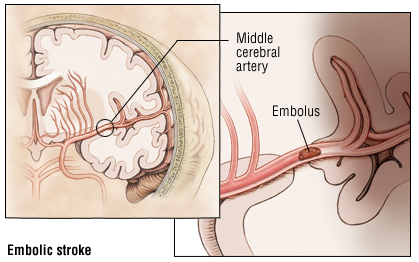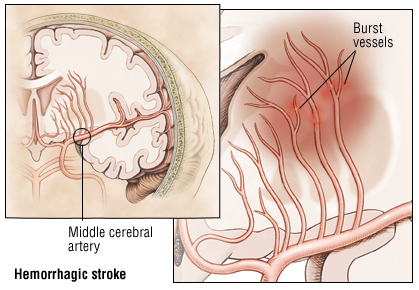A stroke is a disruption of the blood supply to the brain. This can be due to blood clot blocking arteries or leakage of blood. Interruption lasting longer than a few second may cause permanent damage. As a result, brain cells can die, leading to malfunction of areas controlled by the brain. Such areas include movement, speech, and vision.
Ischemic strokes are caused by interruption of the blood supply to part of the brain. An ischemic stroke can occur in two ways: Embolic and Thrombotic strokes
Embolic stroke occurs when a blood clot travels from other parts of the body to the neck or brain to block a smaller artery.
Thrombotic stroke occurs when there is an obstruction of blood vessel by a blood clot forming locally.
Hemorrhagic stroke
Strokes caused by the breakage or rupture of a blood vessel in the brain. The medical word for this type of breakage is hemorrhage. Hemorrhages can be caused by a number of disorders which affect the blood vessels, including long-standing high blood pressure. Hemorrhagic stroke can occur in two ways: Intracerbral and Subarachnoid.
- Intracerbral occurs when there is bleeding from vessels within the brain itself.
- Subarachnoid occurs when blood spills into the area around the brain.
Stroke Risks
High blood pressure is the number on risk factor for strokes. Other factors may increase your risk for stroke:
- Smoking
- Diabetes
- High Cholesterol
- Family history of stroke
- Heart Disease
Prevention
You can help prevent stroke by controlling some of the risk factors. A healthy lifestyle of diet and exercise can also help prevent the risks of stroke.
Treatment
A stroke is a medical emergency and immediate treatment can save lives and reduce disability. It’s important to be aware of strokes symptoms and seek immediate emergency care when experiencing sign of stroke
OCCUPATIONAL THERAPY PERSPECTIVE
- Improve motor control to support functional independence in activities of daily living (ADL) and instrumental activities of daily living (IADL)
- Improve perceptual abilities to support functional independence in ADL and IADL
- Improve cognitive abilities to support functional independence in ADL and IADL
- Support psychosocial processes and adjustment to disability in support of independence ADL and IADL
References
WebMD, article source: Stroke, retreived from: http://www.webmd.com/stroke/guide/stroke-topic-overview
Atchison, Ben J. & Dirette, Dianne K., 2007. Conditions in Occupational Therapy: Effect of Occupational Performance.
Kennealey, Moya., Morgan, Marlene J., Weiss, Donna., 2004. A Practitioner’s Guide to Clinical Occupational Therapy.

